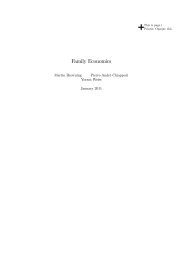Bounded Rationality in Industrial Organization
Bounded Rationality in Industrial Organization
Bounded Rationality in Industrial Organization
You also want an ePaper? Increase the reach of your titles
YUMPU automatically turns print PDFs into web optimized ePapers that Google loves.
6.1 Monopoly pric<strong>in</strong>g with hyperbolic discount<strong>in</strong>g<br />
Della Vigna and Malmendier’s (2004, 2005) work on sell<strong>in</strong>g goods with delayed benefits (or<br />
delayed costs) to time-<strong>in</strong>consistent consumers nicely exhibits the potential of behavioral IO.<br />
Their motivat<strong>in</strong>g example is pric<strong>in</strong>g at health clubs: they th<strong>in</strong>k of consumers as <strong>in</strong>curr<strong>in</strong>g<br />
a short-run disutility when visit<strong>in</strong>g a club, and enjoy<strong>in</strong>g a delayed reward <strong>in</strong> the form of<br />
better health.<br />
The model uses a theoretically appeal<strong>in</strong>g (and practically relevant) degree of generality<br />
<strong>in</strong> pric<strong>in</strong>g. Consumers are <strong>in</strong>itially offered a two-part tariff with an upfront payment of<br />
L and an additional per visit charge of p. If consumers accept this offer, they learn the<br />
disutility d that they will <strong>in</strong>cur if they visit the club, and then decide whether to visit<br />
(which costs p and gives a delayed benefit b.) Note that the decision to accept the two-part<br />
tariff is made under symmetric <strong>in</strong>formation, so <strong>in</strong> a rational model the health club would<br />
extract all consumer surplus via the fixed fee.<br />
Consumers are assumed to have (β, δ) quasi-hyperbolic discount<strong>in</strong>g preferences: from<br />
the perspective of period 0, payoffs <strong>in</strong> period t are discounted by βδ t . They consider both<br />
naive hyperbolic consumers who don’t realize that they have a commitment problem, and<br />
sophisticated hyperbolic consumers who are fully aware of their time <strong>in</strong>consistency.<br />
In this model, one can th<strong>in</strong>k of two reasons why a health club will want to distort p<br />
away from marg<strong>in</strong>al cost. First, sophisticated rational consumers would like to commit<br />
themselves to go to the health club more often. The health club can help them to do this<br />
by sett<strong>in</strong>g p below cost. Second, naive rational consumers will overestimate the number of<br />
times that they will go to the club. Reduc<strong>in</strong>g p and <strong>in</strong>creas<strong>in</strong>g L widens the gap between<br />
the surplus that the consumer expects to receive from accept<strong>in</strong>g the contract and what the<br />
consumer actually receives. Hence, distort<strong>in</strong>g the contract <strong>in</strong> this way makes the contract<br />
more appeal<strong>in</strong>g to these consumers. The two effects go <strong>in</strong> the same direction, so regardless<br />
of what type of hyperbolic consumers we have, we reach the same conclusion: visits will be<br />
priced below marg<strong>in</strong>al cost.<br />
Is this distortion bad? In the case of sophisticated consumers it is not. Essentially,<br />
one can view the health club as sell<strong>in</strong>g a commitment device that allows the consumer to<br />
30













